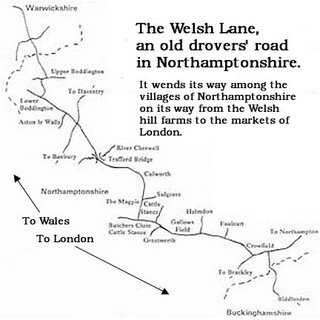 The Border Collie Museum provides a history of droving better than I can relate.
The Border Collie Museum provides a history of droving better than I can relate.
"As the populations of the cities grew, there became a great demand for wool for clothing, beef as food, and skins and hides for shoes, boots, and many other items. With that demand, the number of sheep and cattle raised in the less populated areas and then driven to market, also inclined. The easiest way to transport meat, skins and hides is on the hoof--driving the animals to markets and abattoirs clocer to the populated areas."
Over the centuries, countless drovers, dogs, and livestock wended their way to London. The sights, smells, and sounds must have been truly unique and at times overpowering.
1. Find a history of Smithfield Market where cattle have been driven for over 800 years.
2. The Droving Tradition in the Upper Eden Valley is described in vivid detail here.
3. Wikepedia offers a detailed explanation of drovers and the important role they played in feeding populations in cities
4. At the site of this Inn, The Royal Standard of England, find a recounting of the highwaymen and rakes that haunted the roads to accost unsuspecting (or suspecting) travellers.
With the Industrial Revolution, came The Passing of the Drovers.
"The peace, after the battle of Waterloo in 1815 finished the Napoleonic wars, meant the shrinking navy needed less beef but other changes were even more important. The first half of the nineteenth century saw a revolution in agriculture. Enclosed systems of fields replaced open common grazing and large, fatter cattle were bred and raised ready for market. More importantly, by the 1830s, faster steamships were being built and farmers in the lowlands and elsewhere started to ship cattle directly to the southern markets instead of by the long arduous overland droves. Then, once railways were established by the 1880, this provided an even swifter and more reliable means of transporting cattle and other agricultural products to market. The trade died steadily. "

No comments:
Post a Comment